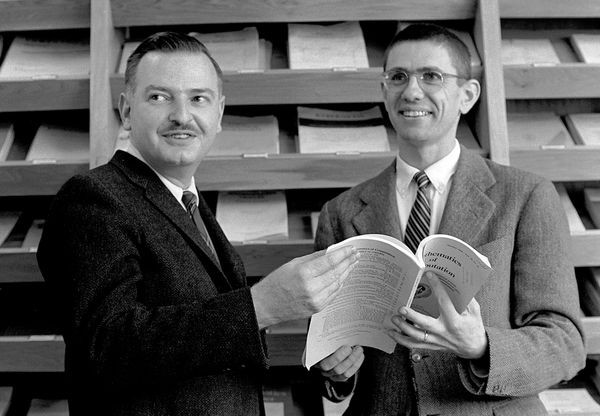The Virtues of Sharing
Children using timesharing terminals
The BASIC computer language was designed for programming beginners.
The Virtues of Sharing
Big companies could afford big mainframes. But what about users with aspirations bigger than their budgets?
Users who can’t individually buy a mainframe can share one. Because most tasks are small, and computers work faster than users can respond, the machine can juggle many jobs—giving users the illusion of having the computer’s undivided attention and providing seemingly real-time access.
CompuServe Pajama Party advertisement
CompuServe began with commercial timesharing in 1969. Some employees objected to introducing “dumbed-down” home-user services starting around 1979, but that became a major CompuServe market.
View Artifact DetailThe Origin of Timesharing
MIT unveiled its Compatible Time-Sharing System (CTSS) in 1961. Initiated by AI pioneer John McCarthy, it operated until 1973 and may have been the first timesharing system available to a large community. It also laid the groundwork for MIT’s Project MAC.
Launched in 1963 with Defense Department support, Project MAC envisioned timesharing available to anyone, anywhere—like telephone or electrical utilities. Project MAC later joined with GE and Bell Labs to develop a prototype commercial timesharing utility called Multics.
By 1985, about 80 Multics systems operated. Several remained in use until 2000. Video (Animation): Animation excerpt from vintage video explaining timesharing concept.
GE 235 computer brochure
Dartmouth created the Dartmouth Time Sharing System (DTSS) in 1963. GE provided the hardware: a 235 mainframe linked to users through a smaller GE Datanet 30 computer.
View Artifact DetailIBM internal newsletter
By 1965, IBM saw that timesharing using its competitors’ computers was becoming popular. The company rushed to enter the timesharing market “next year.”
View Artifact DetailBasic Timesharing
“Be easy for beginners to use.” That was the first of eight design principles behind the Dartmouth Time-Sharing System (DTSS) unveiled in 1963.
Created for both savvy users and non-techies, DTSS used the BASIC programming language, which later was widely available on varied computers, from “game-playing” microcomputers to mainframes.
John G. Kemeny and Thomas E. Kurtz.
BASIC is one of the earliest programming languages designed for beginners. First used in the 1960s, it enjoyed a resurgence in the early personal computer era of the 1970s and 80s. Modern “dialects,” such as Visual Basic, are still used by professional programmers for some applications.
View Artifact DetailGeneral Electric timesharing at Dartmouth advertisement
By 1968, Dartmouth timesharing was running on its second generation of GE computers. GE got an early start in timesharing because IBM declined to support the initial development of Dartmouth’s system.
View Artifact DetailBASIC textbook, "Now YOU Can Program …"
GE promoted Dartmouth’s BASIC programming language to help sell its computers.
View Artifact DetailDatapoint 3300 video terminal
In the late 1960s, video terminals with on-screen editing capability began to replace electromechanical terminals for timesharing systems.
View Artifact Detail








